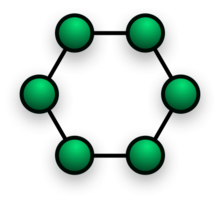Our website is made possible by displaying online advertisements to our visitors.
Please consider supporting us by disabling your ad blocker.
Ring network
This article needs additional citations for verification. (December 2007) |

A ring network is a network topology in which each node connects to exactly two other nodes, forming a single continuous pathway for signals through each node – a ring. Data travels from node to node, with each node along the way handling every packet.
Rings can be unidirectional, with all traffic travelling either clockwise or anticlockwise around the ring, or bidirectional (as in SONET/SDH).[1] Because a unidirectional ring topology provides only one pathway between any two nodes, unidirectional ring networks may be disrupted by the failure of a single link.[2] A node failure or cable break might isolate every node attached to the ring. In response, some ring networks add a "counter-rotating ring" (C-Ring) to form a redundant topology: in the event of a break, data are wrapped back onto the complementary ring before reaching the end of the cable, maintaining a path to every node along the resulting C-Ring. Such "dual ring" networks include the ITU-T's PSTN telephony systems network Signalling System No. 7 (SS7), Spatial Reuse Protocol, Fiber Distributed Data Interface (FDDI), Resilient Packet Ring, and Ethernet Ring Protection Switching. IEEE 802.5 networks – also known as IBM Token Ring networks – avoid the weakness of a ring topology altogether: they actually use a star topology at the physical layer and a media access unit (MAU) to imitate a ring at the datalink layer. Ring networks are used by ISPs to provide data backhaul services, connecting the ISP's facilities such as central offices/headends together.[3][4]
All Signalling System No. 7 (SS7), and some SONET/SDH rings have two sets of bidirectional links between nodes. This allows maintenance or failures at multiple points of the ring usually without loss of the primary traffic on the outer ring by switching the traffic onto the inner ring past the failure points.
- ^ Forouzan, Behrouz A. (2007). Data Communications and Networking. Huga Media. ISBN 9780072967753.
- ^ Bradley Mitchell. "Introduction to Computer Network Topology". About.com. Retrieved January 18, 2016.
- ^ Bartz, Robert J. (24 February 2015). Mobile Computing Deployment and Management: Real World Skills for CompTIA Mobility+ Certification and Beyond. John Wiley & Sons. ISBN 9781118824610.
- ^ Implementación de DOCSIS 3.0 sobre redes HFC. openaccess.uoc.edu. Retrieved 26 January 2024
Previous Page Next Page


